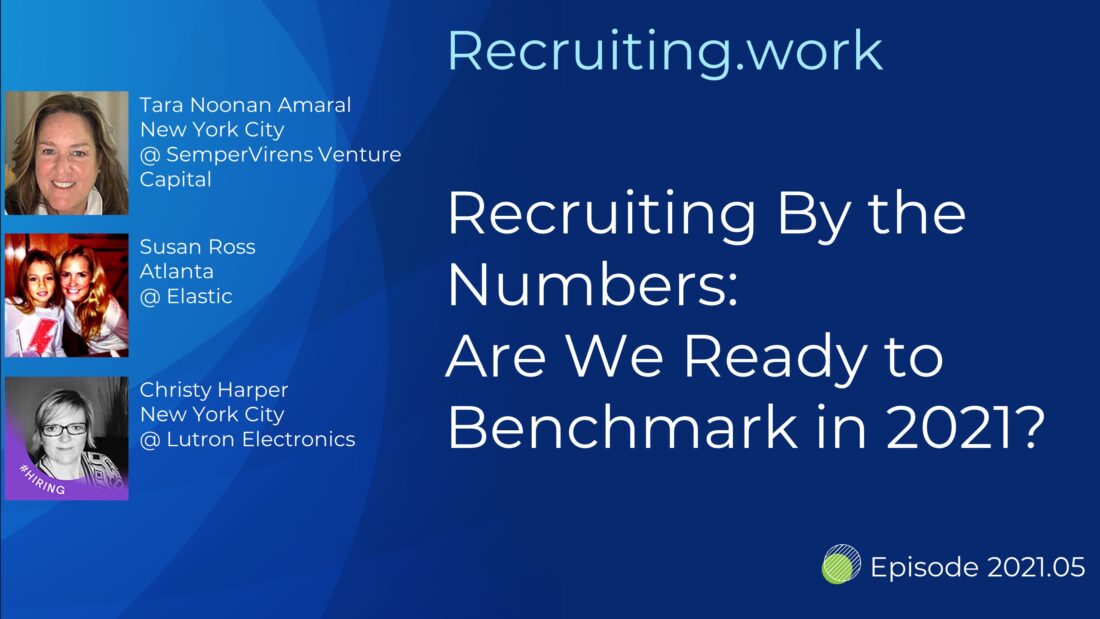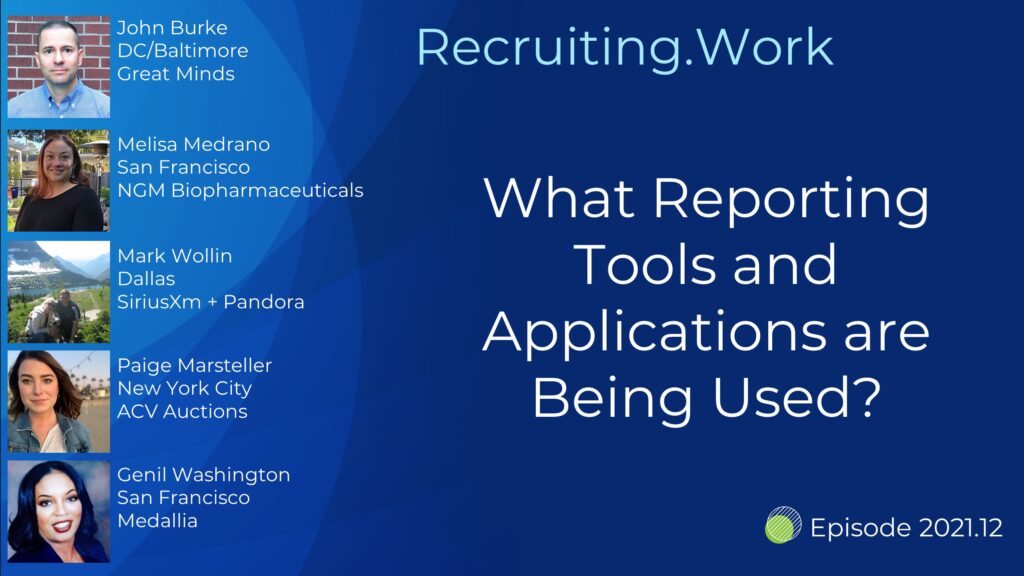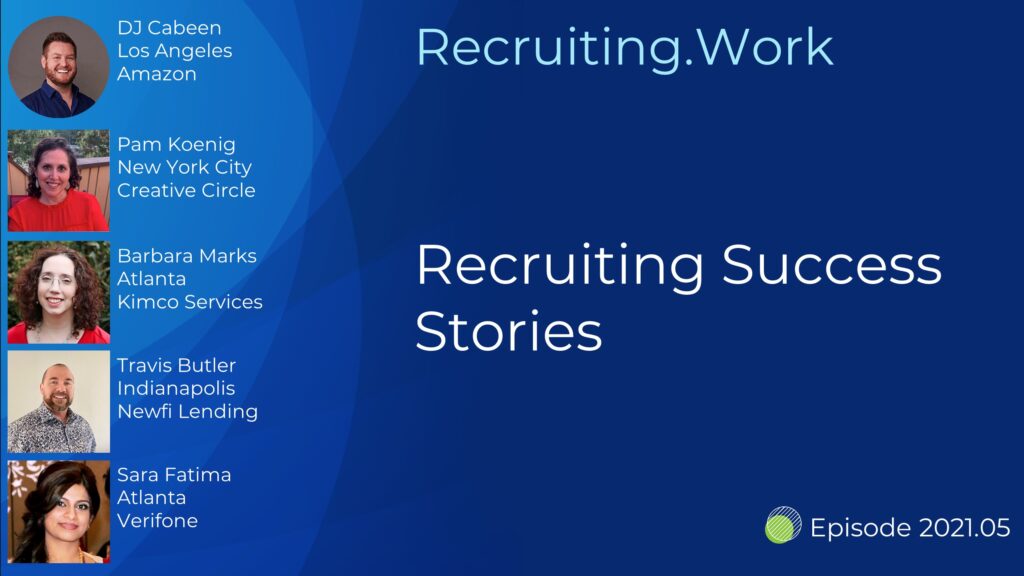This session is part of an ongoing series that focuses on recruiting metrics and benchmarking in the industry.
In today’s round-table session, our panelists talk about what recruiting metrics and benchmarking they will be using in 2021.
Listen in on what our panelists have to say.
This event is part of the “Let’s Talk Recruiting” series where a panel of recruiting practitioners get together online and have a conversation on a variety of topics related to corporate recruiting.
Click to Play the Recording
Our Panelists…
| Name & LinkedIn Profile | Group | Title | Company |
We asked our attendees, “Give your company a grade on how you communicate recruiting activity back to the business:”
The combined grade of everyone’s submission was a C+.
Chat Messages from the Session…
10:01:08 >> Jeanne Amey : Good Morning!
10:01:56 >> Jake Carstensen to All panelists : Good Morning, Hello to all!
10:03:13 >> Jerry Leighton : Hello everyone!
10:06:13 >> Lauren Springer to All panelists : agreed! you need a strategic, tactically minded, consultative coach in the helm of your TA org.
10:07:08 >> Lauren Springer to All panelists : TA org design is critical, this influences resources, tools, processes…everything.
10:10:20 >> Lauren Springer to All panelists : reporting is a manager super power! you’ll learn a lot about processes and performance
10:11:54 >> Lauren Springer to All panelists : reviewing data with recruiters is critical to understanding their process and helping them understand the importance of data quality…good data in, good data out.
10:12:32 >> Tara Noonan Amaral : thanks Lauren
10:13:00 >> Lauren Springer to All panelists : as a new manager, important to listen to how orgs talk about recruiting performance. do they emphasize speed, quality, diversity.
10:17:12 >> Lauren Springer : right now, we are spending more time on the behaviors and beliefs that directly and indirectly impact the data (e.g. diversity, time to fill, source).
10:20:50 >> Lauren Springer : yep! need to build in space for recruiters to breathe and also do work that isn’t direct recruiting but builds critical skills like building and running a program, mentoring, onboarding others, taking a stretch assignment, etc.
10:21:52 >> Lauren Springer : we find that it takes 3 months for a new recruiter to become productive
10:21:58 >> Jeanne Amey : Agree – workload balancing and the boundaries around how that gets done either helps recruiters be productive or burn out unnecessarily
10:22:24 >> Jeanne Amey : I think load depends on industry, skill set, location
10:23:31 >> Lauren Springer : a struggle we’ve seen is accurate forecasting from the business. they will always want more and yesterday, but it’s our job to partner with the biz and finance to be in those meetings and get included.
10:24:00 >> Brad Mumpower : Interested to hear reporting & analytics feedback within Workday Recruiting. We’ll be moving from iCIMS soon.
10:24:27 >> Jeanne Amey : Susan – can you go deeper into what you called “Recruiting Capacity Plan”?
10:24:49 >> Lauren Springer : “hire more recruiters,” won’t fix the technical debt of a poorly managed function
10:25:47 >> Tangeel Cherry : I absolutely agree with creating a capacity model but to a point that’s been made including that volume hiring for certain business, the hiring that’s not considered of factored in. So headcount plan can be on target but volume recruiting often blind sides us which is what I’m working through now.
10:25:52 >> Catherine Hansen : @Susan and panel – curious how you break down the recruiter’s actual workload (eg reqs). For example, in the SF Bay Area, how many roles should an engineering recruiter have, who is hiring industry / mid level SWEs?
10:25:52 >> Lauren Springer : yep! attrition and internal movement creates a lot of work for recruiters on its own
10:27:38 >> Lauren Springer : the fun part is thinking about how WE can be better through reimagining our processes. especially where you hire a lot of the same roles.
10:28:13 >> Daniella McDonald : @Catherine in one of my past roles I had set my team at about 12 positions to fill. However, in my most recent role one recruiter had over 40 reqs and another usually had about 20 postions. So it did depend on what types of roles they were as well as who else I had on the team to handle more positions.
10:30:34 >> Lauren Springer : agreed, focusing on TTF is a poor indicator success
10:30:49 >> Tiffany Byrd to All panelists : Great point about TTF
10:31:00 >> Jeanne Amey : Time to fill is so dependent on the jobs to fill, entry v. senior, are you immigrating the right candidate, etc-
10:31:06 >> Lauren Springer : yes, time to hire (candidate velocity) is a better measure of speed
10:31:16 >> Shawn Watzka : Do any of you post pipeline requisitions on frequently filled positions or hard to filled jobs?
10:31:18 >> Mary Brogan to All panelists : the more valuable metrics are looking at the sub cycle time. Find where your gaps are – what part of the process is slowing you down and attack that.
10:31:25 >> Lauren Springer : and is dependent on level, role, geo, etx
10:31:41 >> Daniella McDonald : I rarely looked at time to fill in my last position. We had reqs that were open for months and months and months because we had multiple reqs to fill, so the main req stayed open until all 6, 8, 9 positions were filled. So that was never a really accurate metric to review.
10:32:05 >> Lauren Springer : speed really depends on the quality of the process and the people driving it.
10:32:49 >> Catherine Hansen : @Panel – how do you measure candidate experience? Such a key measure for employment brand (and a way for recruiters to shine) but seems vaguely understood as important by the business
10:33:55 >> Lauren Springer : there are tools that survey candidates, I’ve even seen companies send their own surveys with a net promoter score type survey
10:35:18 >> Catherine Hansen : Lauren, we do that too. However, outside of HR and marketing, the business doesn’t seem to view candidate experience as important, because it
10:35:29 >> Catherine Hansen : S squishy and non-quantifiable
10:36:12 >> Catherine Hansen : Thank you Christy!
10:36:15 >> Tara Noonan Amaral : survale. qualtrics are all survey tools you can design questions for what you want to measure
10:36:49 >> Lauren Springer : unfortunately, candidate exp isn’t seen as important until it’s an issue. I think you can do the work and use it to influence or tell a story about where the process can be improved.
10:37:20 >> Lauren Springer : look for themes/trends and then dig in with the team to validate
10:37:24 >> Tangeel Cherry : We too just implemented PI. I’ve used it previously and love the tool
10:38:09 >> Daniella McDonald : In my last role we used PI also. I sent it to every candidate I phone screened and then reviewed the results and my screening notes with the hiring manager.
10:38:14 >> Jeanne Amey : Predictive Index is very good – brings predictive analytics into selection for success in the company environment
10:38:31 >> Jeanne Amey : definitely a moving target, Tara!
10:38:33 >> Lauren Springer : we used a similar tool to understand who is great and adapt ideal candidate profiles
10:38:51 >> Daniella McDonald : It was also used with employees about how to manage them, how to communicate with them and what the profile/graph of success in that role would look like.
10:39:27 >> Lauren Springer : great conversation! thanks, everyone!
10:39:59 >> Mary Brogan to All panelists : An effective assessment strategy requires concurrent validation which means assessing the current employee population. This can be tough.
10:44:37 >> Jeanne Amey : Thanks for a great session today!
10:44:52 >> Brad Mumpower : Thank you for an engaging conversation
10:44:59 >> Catherine Hansen : Thank you!!
10:45:09 >> Daniella McDonald : Thank you!
10:45:11 >> Dhiraj Gupta : Thank you for the wonderful insights
10:45:15 >> scott stevenson : Thanks Sean
Some of the attendees…
| Name & LinkedIn Profile | Group | Title | Company |



